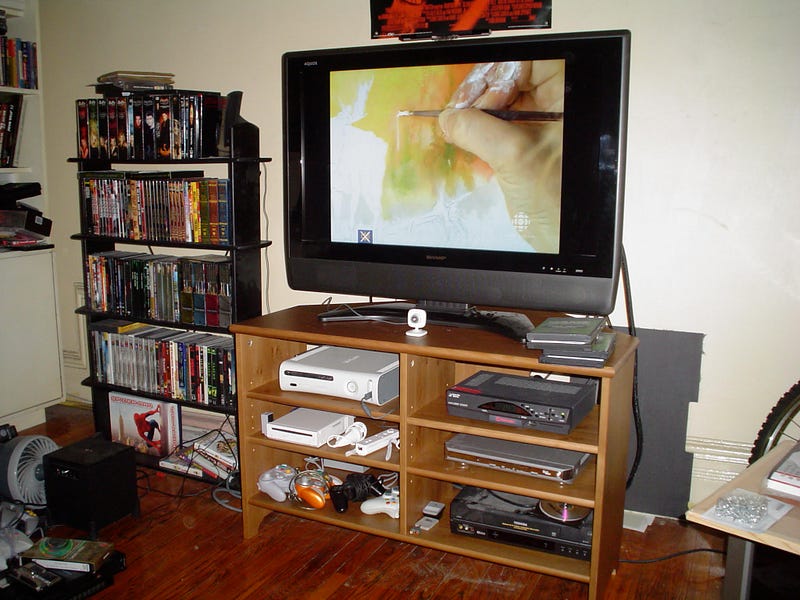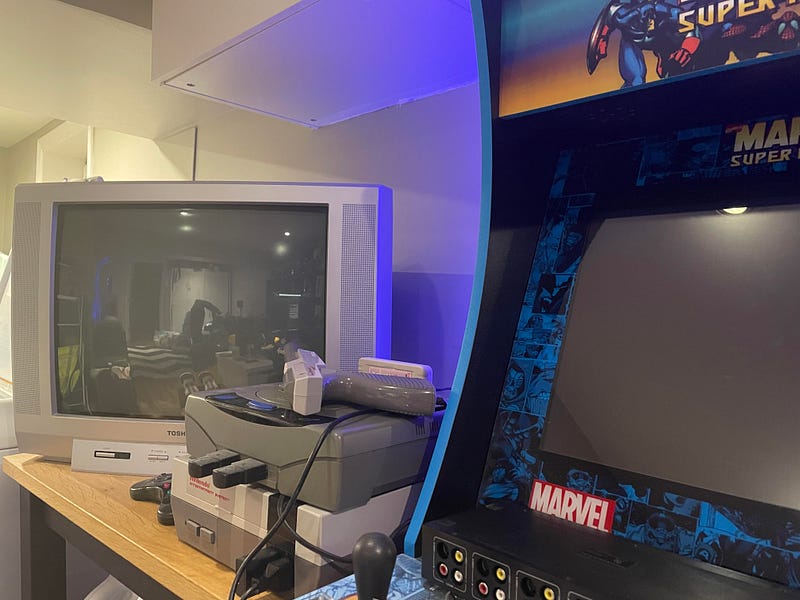# Rediscovering the CRT: A Gamer's Journey Through Nostalgia
Written on
Chapter 1: A Journey Down Memory Lane
I vividly recall tossing out my old, bulky CRT television from the early 2000s. It was a Sony Wega 20” that I purchased on a payment plan from Future Shop, and I cherished that TV. However, my excitement peaked when I replaced it with a sleek 2006 Sharp 37” HDTV, which was not only lighter but also offered a much larger and clearer display.
Just like many gamers, I initially overlooked the advantages of those vintage CRT screens. I never imagined that I would someday long for the pixel-perfect precision of a cramped 4:3 display while revisiting my favorite classic games. Surely, I thought, playing these old titles on a modern television would be sufficient? With technology advancing so rapidly, I felt compelled to embrace progress without questioning it.

My 20" Sony Wega. Yes, I know my room was a mess. (2002)
Despite enjoying modern games in stunning 720p widescreen, I was convinced that I didn’t miss the classics. At least, that’s what I kept telling myself.
The retro gaming itch didn't hit me until much later, and by that time, prices for vintage games had skyrocketed. When the urge finally struck, it started slowly; I just wanted to relive a few of my old favorites. However, I quickly discovered that most publishers were mishandling their retro game libraries, a trend that continues today.
Fortunately, I found that an affordable gaming PC made it easy to turn to emulation to quench my thirst for nostalgia. This approach worked, allowing me to jump into games like Rock n’ Roll Racing within minutes.

My old 37" Sharp. Yes, I should have dusted. (2007)
We live in extraordinary times, but after a while, emulation just didn’t cut it. Two decades of gaming muscle memory had trained me to recognize how those classics should feel. While emulation did a decent job of replicating the experience, it occasionally pulled me out of the moment.
Moreover, the tactile aspect of retro gaming plays a significant role in the nostalgia. There's something special about holding old cartridges or discs, inserting them into original hardware, and flipping through vibrant manuals filled with tips and illustrations. Many of those manuals even featured note sections for recording passwords or secrets.
And who could forget the unique scent of a freshly opened manual? Or was that just my imagination?
The desire for a more authentic retro gaming experience led me to explore FPGA solutions. If you’re curious about what FPGA entails, you can read more about it here.
Chapter 2: Understanding FPGA in Retro Gaming
Retro gaming is rapidly evolving, and here’s what you need to know.
The Analogue suite of consoles, including the Mega SG, Super NT, NT Mini Noir, and Analogue Pocket, has allowed me to enjoy my growing collection while taking advantage of their ability to run ROM images. Although this solution can be pricey, it enables me to use physical media with original controllers on a contemporary TV. FPGA technology also ensures an incredible level of console accuracy, making those classic games feel just as they did in their heyday.

Analogue’s suite of consoles.
So, you’d think I’d be satisfied, right? Have I reached the pinnacle of retro gaming with my FPGA consoles? Yes… and no.
The reality is that not every classic console has a fitting FPGA solution, and the optional HDMI connections introduced in recent years don’t always deliver the best visuals. That’s why I still have a 21” Toshiba CRT sitting behind me, connected to an original Sega Saturn and Nintendo.

The new hotness. (2022)
I’ve come full circle. That cumbersome CRT I once discarded has re-entered my life nearly 20 years later. While it lacks the features of my old Sony Wega—only offering two composite inputs—it serves its purpose just fine.
After years without turning on a CRT, I recently powered up my Toshiba, which I rescued from a friend. The familiar twang and static shimmer were music to my ears. While I don’t plan on using it extensively, retro games look just right on it. Those pixel sprites are displayed in the environments they were originally designed for, and that’s the essence of the CRT experience.
This might not appeal to everyone, but judging by the ongoing scarcity of CRTs and their rising prices on eBay, a niche market is emerging among middle-aged gamers eager to relive their gaming glory days. I hope younger gamers will also want to experience these classic titles as they were meant to be enjoyed.
One aspect I’m particularly excited about, something I once took for granted, is the chance to explore light-gun games. Beyond playing Duck Hunt in the '80s, I never really delved into light-gun gaming outside of arcades, a genre that’s hard to experience on modern televisions. CRTs offer the perfect platform for enjoying those classic light-gun titles, and I can’t wait to dive in.
So, if you’re a dedicated retro gamer and your back can still handle it, consider snagging a CRT television before they become a rare find.
Explore the vibrant world of arcade gaming with "Arkanoid: Revenge of Doh Arcade Cabinet MAME Gameplay w/ Hypermarquee" on YouTube.